The thoughts, observations and adventures of a software engineer and licensed amateur radio operator call sign M0NRD (previously 2E0NRD and M6GTG) with an interest in all things radio related.
Wednesday 28 December 2011
FUNcube Dongle - Oh, yes, my precious!
I received a FUNcube Dongle for Christmas but being away from the 'shack' over the holiday and now back in work I have had little time to do anything with it. I did manage a hour of so last night and updated the firmware and had a little scan around the spectrum using SDR-Radio to receive a few signals.
It is certainly a voyage into the unknown, the FCD came in a simple plastic box with a single sheet of A4 which simply told you to go to www.funcubedongle.com but I found the site it a bit of a mess to be honest. Did get some guides from there but most information seems to be on the Yahoo group http://uk.groups.yahoo.com/group/funcube/
What became obvious last night was I really miss my dual-monitor set up. There were lots of documents, websites and applications that I had open and navigation was a pain on a single 17" LCD.... must replace the dead screen asap.
Friday 23 December 2011
ARISSat-1 'I'm not dead!"
Seems I might have written off ARISSat-1 earlier this month.. might just might get a chance to grab some some signals before it enters the atmosphere http://forums.qrz.com/showthread.php?325959-Good-signals-from-ARISSat-1
APRS decode of last nights ISS pass
Did manage to get the yagi out last night for the ISS pass at around 19:20 GMT. Opted for the Realistic PRO-26 receiver as I'd forgot to put the DJ-X10 on charge. Managed to capture a decent audio file of the ARPS transmissions that lasted just over 10 minutes long. Processed it later with Multipsk.
As you can see from the map above, did manage decode a reasonable number of APRS transmissions. Had a couple of faint transmissions as the ISS came from the west over the Atlantic but the activity didn't really start till it was in range of mainland Europe.
I know Santa is bringing me a Funcube Dongle, so lots more experiments in the New Year!
Thursday 22 December 2011
ISS APRS/Packet
This week with the launch of the Russian Soyuz TMA-03M spacecraft to the International Space Station it occured to me that I have never seen it pass overhead or indeed made any effort to hear any transmissions from it. So off I went to the n2yo.com website to check the pass predictions for the week and was pleasantly surprised to discover that over the Christmas period there are a number of good evening passes (the potenitally visible ones are also listed on the Guardian website)

There are a multitude of frequencies to potentially listen to, some of the operational ones could be quite interesting over the next few days, but at first I was interested in some of the ARISS frequencies.
On Tuesday (20th Dec) evening I popped outside with the 2Meter YAGI, Alinco DJ-X10 and my new found Satellite-AR Android App I did manage to see a faint moving point of light briefly as it came up over the horizon, but quickly lost it due to cloud cover and I think it passed into the Earth's shadow.
I was able to carry on tracking it using the Satellite-AR and picked up some very strong data bursts on 145.825MHz this is the APRS/Packet digirepeater. More details on the ARISS website. APRS in simple terms allows ham operators send a coded data message usually containing their GPS location, call sign and other information. This is received by the digirepeaters and rebroadcast, in the case of the ISS the digirepeater is moving around the earth at nearly 5 miles/second.
Last night (21st Dec) I used the loft mounted antenna and my Realistic PRO-2006 and captured and decoded some of the data on my PC using MultiPSK
Some of the data as it appeared in text form on the screen showing the coordinates, call signs and comments.
@215120h5218.35N/01624.62E-73! via ISS'yI1l -/]Paco en Leganes=
:F6GWB :ack02!5214.25N/00043.40E`Aprx v2.02 SatGate@215356h5218.35N/01624.62E-73! via ISS=4542.75N/01142.00E`73' Via ISS de Cris {UISS52}=3919.07N/00259.59E`73' Via ISS {UISS52}!5310.76N/00532.86E- - 73 - Roland - www.pd2rld.nl -`vDjl -\`73's via ISS ea5hzz.raul@gmail.com_" :SP1TMN-6 :73{17 'vC$l S\]73 FOR ALL=
=4549.52N/01600.66E`[JN85AT] 73 via ISS de Robert - Zagreb - Croatia
!5310.76N/00532.86E- - 73 - Roland - www.pd2rld.nl -
Some more good passes this evening that I might get a chance to capture with YAGI and weather permitting might get to see the point of light as it crosses the sky!

There are a multitude of frequencies to potentially listen to, some of the operational ones could be quite interesting over the next few days, but at first I was interested in some of the ARISS frequencies.
On Tuesday (20th Dec) evening I popped outside with the 2Meter YAGI, Alinco DJ-X10 and my new found Satellite-AR Android App I did manage to see a faint moving point of light briefly as it came up over the horizon, but quickly lost it due to cloud cover and I think it passed into the Earth's shadow.
I was able to carry on tracking it using the Satellite-AR and picked up some very strong data bursts on 145.825MHz this is the APRS/Packet digirepeater. More details on the ARISS website. APRS in simple terms allows ham operators send a coded data message usually containing their GPS location, call sign and other information. This is received by the digirepeaters and rebroadcast, in the case of the ISS the digirepeater is moving around the earth at nearly 5 miles/second.
Last night (21st Dec) I used the loft mounted antenna and my Realistic PRO-2006 and captured and decoded some of the data on my PC using MultiPSK
Some of the data as it appeared in text form on the screen showing the coordinates, call signs and comments.
@215120h5218.35N/01624.62E-73! via ISS'yI1l -/]Paco en Leganes=
:F6GWB :ack02!5214.25N/00043.40E`Aprx v2.02 SatGate@215356h5218.35N/01624.62E-73! via ISS=4542.75N/01142.00E`73' Via ISS de Cris {UISS52}=3919.07N/00259.59E`73' Via ISS {UISS52}!5310.76N/00532.86E- - 73 - Roland - www.pd2rld.nl -`vDjl -\`73's via ISS ea5hzz.raul@gmail.com_" :SP1TMN-6 :73{17 'vC$l S\]73 FOR ALL=
=4549.52N/01600.66E`[JN85AT] 73 via ISS de Robert - Zagreb - Croatia
!5310.76N/00532.86E- - 73 - Roland - www.pd2rld.nl -
Some more good passes this evening that I might get a chance to capture with YAGI and weather permitting might get to see the point of light as it crosses the sky!
Tuesday 20 December 2011
A last look inside space shuttle Atlantis
collectSPACE had the rare opportunity recently to tour the space shuttle Atlantis to photograph its preparation and capture its glass cockpit powered and lit for one of its last times. The photo gallery starts on Atlantis' flight deck, and then proceeds to its now mostly empty middeck, out into and above the 60-foot payload bay, and then around and under the winged spacecraft. The photographs were taken inside Orbiter Processing Facility-2 (OPF-2) at the Kennedy Space Center.
Photograph from collectSpace
Sunday 18 December 2011
Video - From OSCAR 1 to Mars and Beyond
Mentioned on the AMSat-UK website is a fascinating video detailing the history of Amateur Radio Satellites
From OSCAR 1 to Mars and beyond
Amateur Space Exploration -- The last 50 years, now, and the future
Radio amateurs have been building and operating satellites for almost fifty years now, and we are aiming for more. In this talk, I'll present who AMSAT is, what we have achieved in the last fifty years, and what we are working on now.
Back in the 1960's, radio amateurs seized the opportunity of launching a satellite into space. It would not be the only one; we are approaching OSCAR 70 now. Building satellites has always been challenging and involves using technology in creative ways. I'll cover some of the more fascinating cases, including some lessons learned during the process. In addition to the satellites in earth orbit, we are also aiming for Mars, and I'll show what are doing to get there.
Speaker: Mario Lorenz
Event: Chaos Communication Camp 2011 (CCCamp 2011) of the Chaos Computer Club [CCC]
Location: Luftfahrtmuseum Finowfurt, Museumstr. 1, 16244 Schorfheide near Berlin, Germany
ARISSAT-1 nears the end
ARISSat-1 the satellite that has given me some pleasure over the last few months is approaching it's fiery death, it looks like it might make it to the New Year just. http://www.southgatearc.org/news/december2011/arissat1_decay_date.htm
It is a real pity that at the moment the orbit mean I have no chance of capturing anything from it before it's demise. All the passes over the UK are when in shadow and due to the battery failure it is silent.
Thanks ARISSat-1 you have been fun.
It is a real pity that at the moment the orbit mean I have no chance of capturing anything from it before it's demise. All the passes over the UK are when in shadow and due to the battery failure it is silent.
Thanks ARISSat-1 you have been fun.
Saturday 10 December 2011
Satellite Tracking using AR on my Android
In my quest to get better reception of the Russian navigation satellites I have installed the Satellite AR application on my Orange San Francisco Android phone. Up to now I have used a simple compass and a pass prediction to work out where the satellite will appear and how I think it will travel across the sky. Then after having acquired the signal fettling the antenna to get the best signal. While it has given me good results I wasn't convinced I was getting the best signal I could.
The serious method of doing satellite tracking is to use a motorised azimuth antenna rotor connected to a PC running some prediction software. The commercial solutions are hideous expensive and while there are plenty of home-brew solutions available it would still mean a lot of expense in terms of time and money, so I looked for an alternative method.
Then I discovered this brilliant Android app! I used it for the first time late last Sunday evening when it was dark and was suitably impressed, so had a proper attempt in the fading daylight today and was able to take a few photos.
The AR stands for augmented reality and what you get is a view of the sky through the phones camera and overlaid are the positions of any satellites in view. The application uses the phones GPS, compass and accelerometers to work out where the camera is pointing, so you get to see the satellite as if it were visible in the sky. It is really quite spooky!.
I selected the Russian LEO Satellites option for a pass this afternoon and using a couple of elastic bands to lash the phone on to the antenna post I could then point the antenna directly at where the satellite was supposed to be. The satellite today being COSMOS 2429 on 150.030MHz. The main thing I seem to have been doing wrong was while I had the antenna point in the correct bearing I had the elevation far too low. I needed to be pointing it much higher up in the sky.
I was able to got some excellent audio, with the signal still booming in when it had disappeared off the display. I have enclosed a small extract below, note some of the signal fading is because I was trying to take the photos while holding the antenna in my other arm... it gets quite heavy!
Cosmos 2429 10122011 by nerdsville
I brought my phone back in January for the pricey sum of £80. While not the most powerful Android around, only having version 2.1 of the operating system and is prone to crashes and resets it is probably one of the best purchases I have ever made, it is even better now I can use it to chase down signals!
The serious method of doing satellite tracking is to use a motorised azimuth antenna rotor connected to a PC running some prediction software. The commercial solutions are hideous expensive and while there are plenty of home-brew solutions available it would still mean a lot of expense in terms of time and money, so I looked for an alternative method.
Then I discovered this brilliant Android app! I used it for the first time late last Sunday evening when it was dark and was suitably impressed, so had a proper attempt in the fading daylight today and was able to take a few photos.
The AR stands for augmented reality and what you get is a view of the sky through the phones camera and overlaid are the positions of any satellites in view. The application uses the phones GPS, compass and accelerometers to work out where the camera is pointing, so you get to see the satellite as if it were visible in the sky. It is really quite spooky!.
I selected the Russian LEO Satellites option for a pass this afternoon and using a couple of elastic bands to lash the phone on to the antenna post I could then point the antenna directly at where the satellite was supposed to be. The satellite today being COSMOS 2429 on 150.030MHz. The main thing I seem to have been doing wrong was while I had the antenna point in the correct bearing I had the elevation far too low. I needed to be pointing it much higher up in the sky.
I was able to got some excellent audio, with the signal still booming in when it had disappeared off the display. I have enclosed a small extract below, note some of the signal fading is because I was trying to take the photos while holding the antenna in my other arm... it gets quite heavy!
Cosmos 2429 10122011 by nerdsville
I brought my phone back in January for the pricey sum of £80. While not the most powerful Android around, only having version 2.1 of the operating system and is prone to crashes and resets it is probably one of the best purchases I have ever made, it is even better now I can use it to chase down signals!
Monday 28 November 2011
More Russian Passes
This weekend I was supposed to be off to North Yorkshire for a weekend dog agility event. Unfortunately due to a family emergency we were forced to change plans. So yesterday I found my self at home and in between doing some much needed odd jobs I had the chance to get out the 2 meter YAGI and capture a couple of passes of those Russian navigation satellites I blogged about last week.
Each pass lasted the best part of 15 minutes from the first faint signal acquisition to finally losing it as it sped out of range. Below is an except from the first pass at around 10:00 UTC. The signal is clear and the different tones used can be clearly distinguished. These captures should prove useful for testing any decoder.
Russian Parus Satellite 27-11-2011 by nerdsville
It is quite fun standing with the antenna and pointing in the direction where I expecting the satellite to appear and then once the signal is acquired then fettling it during the pass to maintain the best signal strength.
Not sure what my neighbours are making of all these antics, perhaps I should try to find that extension cable so I can use headphones to monitor the pass rather than letting it blast out the laptop speaker! It must look odd me standing there waving an huge antenna about and receiving strange foreign voices (from the ARISSat-1 satellite) and now this weird 'morse code'
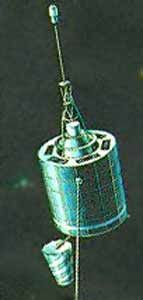
Dasvidania!
Each pass lasted the best part of 15 minutes from the first faint signal acquisition to finally losing it as it sped out of range. Below is an except from the first pass at around 10:00 UTC. The signal is clear and the different tones used can be clearly distinguished. These captures should prove useful for testing any decoder.
Russian Parus Satellite 27-11-2011 by nerdsville
It is quite fun standing with the antenna and pointing in the direction where I expecting the satellite to appear and then once the signal is acquired then fettling it during the pass to maintain the best signal strength.
Not sure what my neighbours are making of all these antics, perhaps I should try to find that extension cable so I can use headphones to monitor the pass rather than letting it blast out the laptop speaker! It must look odd me standing there waving an huge antenna about and receiving strange foreign voices (from the ARISSat-1 satellite) and now this weird 'morse code'

Dasvidania!
Wednesday 23 November 2011
Russian Satellites
At the weekend I attended a dog agility show in the depths of Cambridgeshire, there is always a lot of waiting around in between runs and so I was sat in the foggy car park. To pass the time I had taken along my PRO-26 scanner. I monitored amateurs on GB3PY and GB3OV chatting about the tropospheric 'lift' they were experiencing, found a few taxi firms complaining about the fog, some hospital paging but it was pretty boring.
I was idly scanning around when I happened across a strange signal on 149.9375Mhz. I could hear a definite doppler shift in the tones so it was a satellite. Checking my pretty useless 9th Edition UK Scanning Directory the frequency was identified as being in the Russian radio navigation and satellite beacon band.
Over the last couple of days I have done some research and discovered it is the Russian Parus Navigation System which dates back to the 1970s. The transmission was in fact on 149.940Mhz but I had the scanner set on 12.5kHz stepping. I have been trying to track and capture more of the signals but had been hampered by a persistent source of interference at home, but did get some audio
Russian Parus Satellite by nerdsville
I found an excellent thread on the UK Vintage Radio Repair and Restoration Discussion Forum with some information supplied by Alan Cordwell who is/was developing a Java decoder.
I would like to decode these signals at some point, providing I can sort out reception. I have found a number of historical guides and projects in addition to the articles linked to in the thread above.
A Time Code Reader/Display for Russian Tsikada Satellites by John M.Franke WA4WDL contained in the Proceedings of the AMSAT-NA14th Space Symposium and AMSAT Annual Meeting 1996
and Decoding the Russian LEO Navigation Satellites by John Corby, VA3KOT contained in the Ontario DX Association magazine Listening In Nov 2005, Dec 2005
I was idly scanning around when I happened across a strange signal on 149.9375Mhz. I could hear a definite doppler shift in the tones so it was a satellite. Checking my pretty useless 9th Edition UK Scanning Directory the frequency was identified as being in the Russian radio navigation and satellite beacon band.
Over the last couple of days I have done some research and discovered it is the Russian Parus Navigation System which dates back to the 1970s. The transmission was in fact on 149.940Mhz but I had the scanner set on 12.5kHz stepping. I have been trying to track and capture more of the signals but had been hampered by a persistent source of interference at home, but did get some audio
Russian Parus Satellite by nerdsville
I found an excellent thread on the UK Vintage Radio Repair and Restoration Discussion Forum with some information supplied by Alan Cordwell who is/was developing a Java decoder.
cosmos 2407 149.970 22/07/2004 28380There is also a lot of information about the Soviet space program on the Zarya website
cosmos 2414 149.970 20/01/2005 28521
cosmos 2429 150.030 11/09/2007 32052
cosmos 2454 149.940 21/07/2009 35635
cosmos 2463 149.940 27/04/2010 36519
These satellites are very easy to receive on a handheld scanner though obviously you'll get better results on an external antenna. The tx power is about 10 watts (+40 dBm) so with a 140dB path loss on an overhead pass (alt = 1000 km) you'll get about a microvolt in a zero-gain antenna, which is enough to hear.
The VHF frequency carries the time data and orbital parameters for the current and other satellites. There is a second transmission on around 400MHz- its in an 3:8 ratio with the VHF carrier frequency. This is unmodulated- i.e cw. It is used to measure the Doppler shift, to determine when the satellite is dead abeam the observer. The transmitted time, and the orbital data, tell you where the satellite was in the sky when that happened- or, put another way, if you know where the satellite is relative to you, then you know where you are- well, you're somewhere on a line at right angles to the satellite's track. You then wait for another satellite, and obtain another poition line- and where they cross, then bingo- that's where you are. Hope that makes sense!
Parus could give you a fix in 1-2 hours; and had an accuracy of 100m anywhere on the earth's surface. Okay that's poor compared to GPS, but in the 1970's it was revolutionary.
It isn't just Doppler that determines the receiver bandwidth, although you do take it into account. Most satellites have a much higher FM deviation than a normal narrowband FM transmission- the NOAA met sats are about 19kHz deviation I think- and these nav sats are higher too, but not that much. But for decoding, you do need to resolve the 7kHz second markers which a narrow filter won't easily do.
I would like to decode these signals at some point, providing I can sort out reception. I have found a number of historical guides and projects in addition to the articles linked to in the thread above.
A Time Code Reader/Display for Russian Tsikada Satellites by John M.Franke WA4WDL contained in the Proceedings of the AMSAT-NA14th Space Symposium and AMSAT Annual Meeting 1996
and Decoding the Russian LEO Navigation Satellites by John Corby, VA3KOT contained in the Ontario DX Association magazine Listening In Nov 2005, Dec 2005
Labels:
decode,
navigation,
parus,
russian,
satellite,
scanner,
vintage radio
Sunday 13 November 2011
ARISSat-1 - The results just keep getting better
As I mentioned in yesterdays post, this weekend saw a couple of well timed passes of ARISSat-1, today had two which seemed to offer the possibility of decent results.
So the setup again was I'd have the PRO2006 in the spare room on the loft mounted discone to capture any SSTV images and the Yagi with the Alinco DJ-X10 in the garden to capture the CW beacon. The first pass yielded rubbish results from both setups, the beacon was very faint (I suspect I haven't got something quite right for receiving the SSB/CW modes) but as I lost signal at the end of the pass I switched the Alinco to FM on 145.950MHz and got a really strong signal!
The decision was made! For the second pass I decided not to bother with the beacon and get a FM capture with the Alinco.. well glad I did got a cracking full 5 minutes of voice and three sstv images, including a beautiful one of the blue marble!
The normal PRO2006 setup yielded nothing worthy of including here!
Arissat1 1311111140 by nerdsville
So the setup again was I'd have the PRO2006 in the spare room on the loft mounted discone to capture any SSTV images and the Yagi with the Alinco DJ-X10 in the garden to capture the CW beacon. The first pass yielded rubbish results from both setups, the beacon was very faint (I suspect I haven't got something quite right for receiving the SSB/CW modes) but as I lost signal at the end of the pass I switched the Alinco to FM on 145.950MHz and got a really strong signal!
The decision was made! For the second pass I decided not to bother with the beacon and get a FM capture with the Alinco.. well glad I did got a cracking full 5 minutes of voice and three sstv images, including a beautiful one of the blue marble!
The normal PRO2006 setup yielded nothing worthy of including here!
Arissat1 1311111140 by nerdsville
Saturday 12 November 2011
ARISSat-1 Morse beacon
This weekend there are a couple of excellent daytime flybys of ARISSat-1 predicted, passing very high in the sky.
Up till now I have been concentrating on the FM transmission on 145.950MHz which carries the voice messages, voice telemetry and the SSTV. The other signals from the satellite use SSB and CW modulation.
So this morning I left the loft discone and my Realistic PRO2006 with MMSSTV in the spare bedroom waiting for the pass while I took the borrowed Alinco DJ-X10, which has SSB capability, outside and using the Yagi antenna I built up last weekend had a go at getting some of the CW beacon on 145.919MHz
I got a decent signal as you can hear below, and using CWGet managed to decode some of the telemetry and the identification, but the high noise and doppler effect did cause some problems.
Arissat1 cw beacon by nerdsville
While I was doing this the SSTV system caught a lovely image

Can not wait till tomorrow for two almost overhead passes in the morning and then time to watch the Grand Prix!
So this morning I left the loft discone and my Realistic PRO2006 with MMSSTV in the spare bedroom waiting for the pass while I took the borrowed Alinco DJ-X10, which has SSB capability, outside and using the Yagi antenna I built up last weekend had a go at getting some of the CW beacon on 145.919MHz
I got a decent signal as you can hear below, and using CWGet managed to decode some of the telemetry and the identification, but the high noise and doppler effect did cause some problems.
Arissat1 cw beacon by nerdsville
While I was doing this the SSTV system caught a lovely image

Can not wait till tomorrow for two almost overhead passes in the morning and then time to watch the Grand Prix!
Monday 7 November 2011
Now I'm Depressed
Following on from yesterday's adventures, checking out the AMSAT-UK website found this blog http://ariss-sstv.blogspot.com/ and this gallery of images http://www.amsat.org/amsat/ariss/SSTV/
Makes my efforts look rubbish! ;-)
Makes my efforts look rubbish! ;-)
Sunday 6 November 2011
Satellite experiments with the YAGI
There were a couple of reasonable passes of the ARISSat-1 satellite predicted this afternoon so I decided to try out the nice new InnovAntennas 4 element 144MHz LFA Yagi which my brother won in the prize draw at this years National Hamfest.
Well this is how it arrived, a big cardboard tube that has been sitting in my workshop since October.
Taking everything out the box, lots of metal work, but no instructions!
It was fairly logical to put together, but wasn't absolutely sure how the folded dipole element went together and the u-shaped end pieces slotted in with no apparent fixings to hold them in place (I assume they are missing along with the instructions) There was also a piece that fitted under the antenna. I am no expert on antenna design so checked the InnovAntenna website but it was no help, lots of graphs and radiation patterns but and not one images of the actual antenna to look at! Looking at a small picture on the Waters and Stanton blog I made a guess as to how it should be put together.
I connected up a bit of coax, and screwed it a short wooden post I had. The end pieces of the folded dipole slipped in and seemed to be fairly secure but probably not brilliant electrically, so will need to secure them properly if I ever use this in anger.
It is lightweight and easy to move about, so I was ready to get going
The satellite passes are from west to east and to the south of my location. So would have to do this at the end of the garden to minimise obstuctions from houses and trees. I would be well away from my normal computer and scanner in the spare bedroom! I decided to use my Realistic PRO-26 hand-held scanner, which is a good performer and has a relatively clean unprocessed audio output (can decode pagers and ascars quite well with it)
I used an old Pentium III laptop running Windows 2000 to capture the audio. I didn't attempt any decoding of the SSTV directly just captured the wav files so I could edit and process them later. The laptop has dead batteries but could be powered from the summerhouse mains and so with a few extension cables I could have a relatively clear view of the sky and have access to the scanner to adjust levels and could monitor the audio from the laptop!
I experimented with the first pass, at around 13:30 UTC and got a decent signal eventually, but it took a bit of trial and error as the polarisation seems to change during the pass. For the second at 15:14 UTC I set up the camera to record my efforts! The audio in the video is just being picked up by the microphone on the camera so has a lot of background noise, but as you can hear it was at times a fairly strong signal! I had my usual unattended setup going in the spare bedroom and got nothing on either pass!
I have uploaded the two audio files of each pass to Soundcloud
ARISSat1 0611111330 by nerdsville
ARISSat1 0611111514 by nerdsville
Here are the images decoded from the audio.. slight sync problems which I suspect is the underpowered laptop - I did have it capturing at 44.8KHz, 32 bit resolution, which was probably an overkill in hindsight!
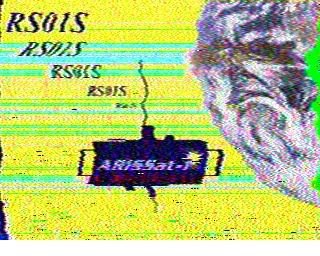
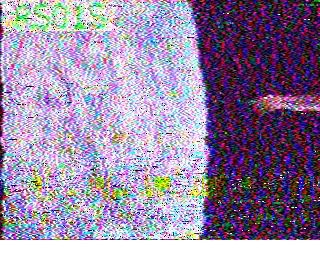
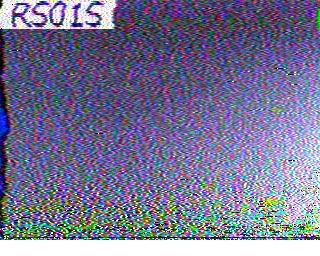
But on the whole it was a fun way to spend the afternoon with some nice results.
Well this is how it arrived, a big cardboard tube that has been sitting in my workshop since October.
Taking everything out the box, lots of metal work, but no instructions!
It was fairly logical to put together, but wasn't absolutely sure how the folded dipole element went together and the u-shaped end pieces slotted in with no apparent fixings to hold them in place (I assume they are missing along with the instructions) There was also a piece that fitted under the antenna. I am no expert on antenna design so checked the InnovAntenna website but it was no help, lots of graphs and radiation patterns but and not one images of the actual antenna to look at! Looking at a small picture on the Waters and Stanton blog I made a guess as to how it should be put together.
I connected up a bit of coax, and screwed it a short wooden post I had. The end pieces of the folded dipole slipped in and seemed to be fairly secure but probably not brilliant electrically, so will need to secure them properly if I ever use this in anger.
It is lightweight and easy to move about, so I was ready to get going
The satellite passes are from west to east and to the south of my location. So would have to do this at the end of the garden to minimise obstuctions from houses and trees. I would be well away from my normal computer and scanner in the spare bedroom! I decided to use my Realistic PRO-26 hand-held scanner, which is a good performer and has a relatively clean unprocessed audio output (can decode pagers and ascars quite well with it)
I used an old Pentium III laptop running Windows 2000 to capture the audio. I didn't attempt any decoding of the SSTV directly just captured the wav files so I could edit and process them later. The laptop has dead batteries but could be powered from the summerhouse mains and so with a few extension cables I could have a relatively clear view of the sky and have access to the scanner to adjust levels and could monitor the audio from the laptop!
I have uploaded the two audio files of each pass to Soundcloud
ARISSat1 0611111330 by nerdsville
ARISSat1 0611111514 by nerdsville
Here are the images decoded from the audio.. slight sync problems which I suspect is the underpowered laptop - I did have it capturing at 44.8KHz, 32 bit resolution, which was probably an overkill in hindsight!



But on the whole it was a fun way to spend the afternoon with some nice results.
Saturday 5 November 2011
Yet another picture from space!
Been out all day, but left the computer and scanner on. The MMSSTV software grabbed this image from ARISSat-1 at 14:54
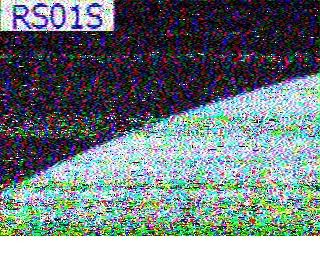
Hopefully will get chance to get the YAGI out tomorrow afternoon, looks like a good pass at 13:38 over the UK! http://www.n2yo.com/passes/?s=37772

Hopefully will get chance to get the YAGI out tomorrow afternoon, looks like a good pass at 13:38 over the UK! http://www.n2yo.com/passes/?s=37772
Friday 4 November 2011
ARISSat-1 Still Transmitting
ARISSat-1 is getting nearer the atmosphere but is still functional and the orbital passes have moved back into daylight over the UK so set up the gear again this week to try to get some more SSTV images. Results have been a bit poor, but did get the back end of a very nice image this afternoon clearly showing some cloud formations in the atmosphere.
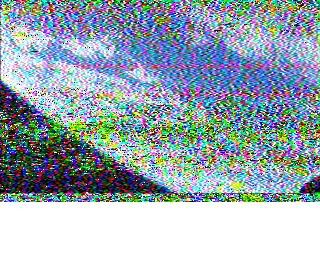
Now got an excuse this weekend to try out the nice new yagi that we won in the prize draw at the Hamfest at the start of the October that is still sitting in the box! It sounds pretty good. http://blog.wsplc.com/?p=431
Oh and as I threatened too I have joined AMSAT-UK, now just saving up for my FunCube Dongle.

Now got an excuse this weekend to try out the nice new yagi that we won in the prize draw at the Hamfest at the start of the October that is still sitting in the box! It sounds pretty good. http://blog.wsplc.com/?p=431
Oh and as I threatened too I have joined AMSAT-UK, now just saving up for my FunCube Dongle.
Tuesday 1 November 2011
Radio Rusty Bolt?
Not had too much time over the last week or so to do much radio wise, but the other day while scanning around in the vhf low band found an odd signal on one of my scanners at 70.860MHz. This is the part of the spectrum that was used by the fire brigade until the introduction of the airwave system. Strangely it was a WFM signal and after a few minutes of music identified itself as BBC Radio Nottinghamshire!
Where I live isn't brilliant for radio reception, but the BBC station is one of the stronger due to a nearby local 'fill-in' transmitter so I suspected it was breakthrough or some product of intermodulation. However I wasn't sure if it wasn't some 'cordless headphones' or other form of AV link or baby alarm given the proliferation of Chinese cheap and cheerful FM modules available that can operate at this frequency. That now seems very unlikely as the signal has been present continuously for days now.
To try to rule out any internally generated image I tried some of my other scanners, with different antennas and found the signal on them too. However one of them did exhibit some pager breakthrough as can be seen in the following video.
It therefore does suggest to it being an intermodulation product, but exactly what is causing it I am unsure. We have cast iron guttering on the house which has been recently repainted, so could this be caused by a rusty bolt that has been disturbed now acting as a diode?
Very curious...
Where I live isn't brilliant for radio reception, but the BBC station is one of the stronger due to a nearby local 'fill-in' transmitter so I suspected it was breakthrough or some product of intermodulation. However I wasn't sure if it wasn't some 'cordless headphones' or other form of AV link or baby alarm given the proliferation of Chinese cheap and cheerful FM modules available that can operate at this frequency. That now seems very unlikely as the signal has been present continuously for days now.
To try to rule out any internally generated image I tried some of my other scanners, with different antennas and found the signal on them too. However one of them did exhibit some pager breakthrough as can be seen in the following video.
It therefore does suggest to it being an intermodulation product, but exactly what is causing it I am unsure. We have cast iron guttering on the house which has been recently repainted, so could this be caused by a rusty bolt that has been disturbed now acting as a diode?
Very curious...
Labels:
intermodulation,
radio
Monday 24 October 2011
NOAA Weather Satellites and SDR
One site I have in my Google Reader list and check regularly is the Hackaday blog
The main project website describes using a Softrock homebrew SDR(software defined radio) to get the necessary audio file to import into WxImg decoder.
I have been toying with getting hold of the AmSat-UK FunCube SDR dongle, which is now available from Martin Lynch and Sons and using it in a similar way after seeing this article a while back.
One project they recently featured was Grab your own images from NOAA weather satellites
The main project website describes using a Softrock homebrew SDR(software defined radio) to get the necessary audio file to import into WxImg decoder.
I have been toying with getting hold of the AmSat-UK FunCube SDR dongle, which is now available from Martin Lynch and Sons and using it in a similar way after seeing this article a while back.
Wednesday 5 October 2011
UVB-76 - A Wired Magazine Article
Wired magazine have an interesting article about the famous Russian 'Number Station' UVB-76
Number stations are fascinating, growing up during some one the tense periods of the Cold War I remember listening to very strange transmissions on the old short wave. It brings back memories to hear recordings of the Russian Woodpecker nowadays listeners just have to put up with the din produced by PLT devices.
Also on the Wired magazine website was a feature about another relic of the Cold War an abandoned NSA listening post.
Labels:
cold war,
shortwave,
wired magazine
Tuesday 4 October 2011
Sky News Cock Up
Slight cock up on Sky News this morning, unable to watch it on Freeview due to constant promotion of Challenge and Holidays channels....
Monday 3 October 2011
National Hamfest Video by M0OGY
Nice little video of the National Hamfest by
Dave M0OGY
Chairman
BDARC North Lincolnshire UK
http://www.bdarc.co.uk/
Dave M0OGY
Chairman
BDARC North Lincolnshire UK
http://www.bdarc.co.uk/
Saturday 1 October 2011
National Hamfest 2011
Glorious sunshine today at the Newark Showground for the Hamfest, had a good time and despite the temptations didn't spend lots of money just a few books from the RSGB stand. My brother got himself a new antenna to hopefully improve his scanner reception. But the highlight of the day was him winning a 4-element 2m Yagi antenna in the prize draw! It was the last draw of the show and with six no-shows for the prize, he won it on the seventh redraw! I had jokingly said to him we will give it one more chance and then we will go....
He cannot really use it, so I currently have the antenna and may set it up if I can find somewhere to mount it!
He cannot really use it, so I currently have the antenna and may set it up if I can find somewhere to mount it!
Friday 30 September 2011
National Hamfest 2011
Today sees the start of National Hamfest 2011 at the Newark and Nottinghamshire Showground. I went for the first time last year and am attending again this year, going tomorrow with my brother, so will probably end up goading each other in buying lots of expensive toys!
It looks like the weather will be much better than the wash-out it was last year!
It looks like the weather will be much better than the wash-out it was last year!
photo from National Hamfest
Wednesday 28 September 2011
Solar Flares
Not sure what is going on, but both computers I use at work have just borked, one just froze completely and no option to turn it off and on again, the other was reporting one of the drives in the RAID had failed!
Yesterday one of co-workers computers developed an unmountable boot volume BSOD while he was out the office....
I jokingly tweeted about solar flares being the culprit, I know solar activity has been on the increase but little did I know that in fact there have been some severe coronal mass ejections in the past week due to a huge sun spot and there is a resulting geomagnetic storm
Going to keep an eye on http://www.solarham.com/ for more data, however like the sun itself I wouldn't recommend looking at it directly without some eye protection!
Yesterday one of co-workers computers developed an unmountable boot volume BSOD while he was out the office....
I jokingly tweeted about solar flares being the culprit, I know solar activity has been on the increase but little did I know that in fact there have been some severe coronal mass ejections in the past week due to a huge sun spot and there is a resulting geomagnetic storm
AR1302
Alan Friedman via Bad Astronomy
Going to keep an eye on http://www.solarham.com/ for more data, however like the sun itself I wouldn't recommend looking at it directly without some eye protection!
Labels:
cme,
flare,
geomagnetic,
solar,
solarham.com
Tuesday 27 September 2011
Homebrew ADS-B
One of the most interesting and therefore popular things to monitor on a radio scanner are the airband transmissions. Listening to aircraft communicating with air-traffic control can be quite addictive, especially if you are able to hear transmissions from the tower of a busy airport.
Several years ago the geek factor for would be air-traffic controllers soared with the introduction of virtual radar systems. These units monitor the Automatic dependent surveillance-broadcast (ADS-B) that all modern aircraft now transmit in the 1090MHz band.
My younger brother who lives near Birmingham International brought a system a while ago and has great fun watching the approach of aircraft on 'radar' as they rattle the roof tiles on approach to BHX.
Not being a wealthy as my brother I have been looking for a cheaper alternative... and on Hackaday perhaps I have found one...or maybe not...
A simple decoder made from some salvaged parts from an old satellite receiver!
http://hackaday.com/2011/09/22/tracking-commercial-aircraft-with-salvaged-electronics/
http://www.lll.lu/~edward/edward/adsb/VerySimpleADSBreceiver.html
Until then I will have to make do with more low tech ACARS decoding.
Several years ago the geek factor for would be air-traffic controllers soared with the introduction of virtual radar systems. These units monitor the Automatic dependent surveillance-broadcast (ADS-B) that all modern aircraft now transmit in the 1090MHz band.
My younger brother who lives near Birmingham International brought a system a while ago and has great fun watching the approach of aircraft on 'radar' as they rattle the roof tiles on approach to BHX.
Not being a wealthy as my brother I have been looking for a cheaper alternative... and on Hackaday perhaps I have found one...or maybe not...
A simple decoder made from some salvaged parts from an old satellite receiver!
http://hackaday.com/2011/09/22/tracking-commercial-aircraft-with-salvaged-electronics/
http://www.lll.lu/~edward/edward/adsb/VerySimpleADSBreceiver.html
Until then I will have to make do with more low tech ACARS decoding.
Tuesday 20 September 2011
Twitterfeed - you are getting on my tits!
Now I am regularly updating my blog I enabled twitterfeed.com to post to updates to my twitter feed and facebook pages to informed the frankly uninterested masses about my technical perversions.
Well it seems to be broken and unreliable, either doesn't post or misses off the bit.ly url so no one can follow the link! - I have been in yet again and changed the settings, hopefully this works!
Well it seems to be broken and unreliable, either doesn't post or misses off the bit.ly url so no one can follow the link! - I have been in yet again and changed the settings, hopefully this works!
Labels:
facebook,
twitter,
twitterfeed
Monday 19 September 2011
PSK-31
Just spent the evening playing with PSK-31 using Digipan on my PC. I found some informative videos on K7AGE's youtube channel. The video below is just an introduction, there are more dealing with interfacing, setting up etc.
Inspired by it I got the Alinco DJ-X10 in USB mode and tuned into 14.070MHz and sure enough got loads of messages from amateurs with very little effort.
Obviously following on from the SSTV experiments I soon hooked up a couple of PMR446 handhelds and sent a few messages going across the ether!
Got a few wav files in the MP3 player so I will probably do some field trials tomorrow!
Inspired by it I got the Alinco DJ-X10 in USB mode and tuned into 14.070MHz and sure enough got loads of messages from amateurs with very little effort.
Obviously following on from the SSTV experiments I soon hooked up a couple of PMR446 handhelds and sent a few messages going across the ether!
Got a few wav files in the MP3 player so I will probably do some field trials tomorrow!
Thursday 15 September 2011
Binatone Worldstar circa 1978
 Be Back Soon
Be Back Soon
Labels:
binatone,
restoration,
shortwave,
vintage radio,
worldstar
Wednesday 14 September 2011
SSTV on PMR446
Following on from my experiments in receiving slow-scan television (SSTV) from the ARISSat-1 satellite I was intrigued by the prospect of actually transmitting and receiving some images myself.
Being unlicensed the only legal equipment I can used is PMR446 these are low power (500mW) handheld transceivers with very limited range. I have several some older models kicking about from when I built a eQSO internet PMR446 gateway.
The SSTV image is transmitted by frequency modulation using a varying audio tone to indicate different brightnesses. The software I have been using to decode SSTV is MMSSTV by JE3HHT (Makoto Mori) It can also be used to transmit SSTV images by connecting the audio output of the PC to the transmitter audio in. It allows editing and customisation of the images and the encoding format to use.
Obviously I couldn't carry a PC around so instead I generated some images and recorded the generated sound to a WAV audio file and then used an old cheap MP3 player (which supported WAV files) connected to one of the Audiovox PMRS-838 handsets, configured to operate in VOX mode.
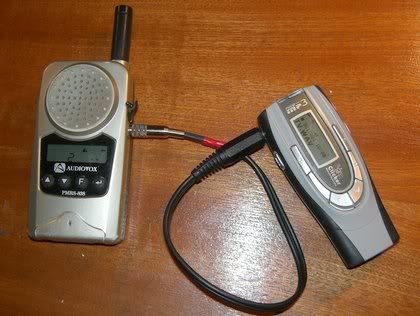
The plan was to drive around to a number of local high spots and with the transceiver on the dashboard of the card output a series of images and see if they could be received and decoded back at base! - Each image taking around 2 minutes to transmit.
The base receiver was my Alinco DJ-X3 connected to the loft based discone. I had to use the DJ-X3 because it supports to 6.25kHz narrow band channel step required by the PMR446 channel allocations.

Well the first set of results today have been pretty good, I went to three sites to transmit from and using the terrain profiler on HeyWhatsThat.com I could calculated any obstacles in the line of site..The base is on the left hand side, the transmission point on the right of the diagrams below.
Site 1, was 0.9 miles from home This site is just across on the other side of the Trent Valley with no significant buildings in the transmission path.

as you can see the five images all came across very well, just a slight sync error on one.
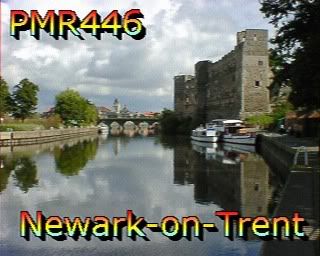



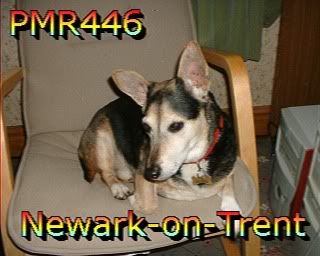
Site 2, was 1.2 miles from home and is one of the local high spots. Unfortunately there is a housing estate on the top of the hill. It is possible to go by foot on some footpaths to get into some fields with a clear vantage point across the town and down the Trent Valley towards Nottingham. However today these were from the car parked up near to the edge of the estate. I just sent two images - and they are a lot nosier.

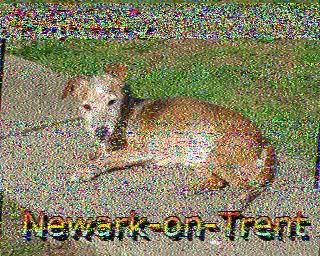
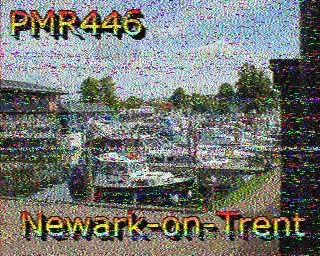
Site 3, was 3.2 miles from home and is on a slight high spot across on the other side of the Trent Valley. I parked up in a layby and transmitted three images and really wasn't expecting much. So was very pleasantly surprised by the high quality of the received images, as you can see there isn't any geographical obstruction but there is a very big new power station at Staythorpe in the line of transmission which I expected to cause some issues. Some of the lines of noise on the images I suspect were caused when large lorries and vans were passing by on the road momentarily blocking the transmission path as it is quite a busy road.

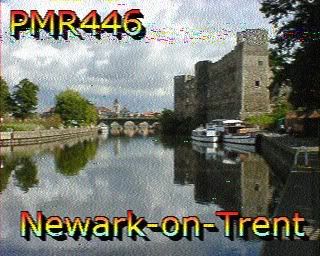
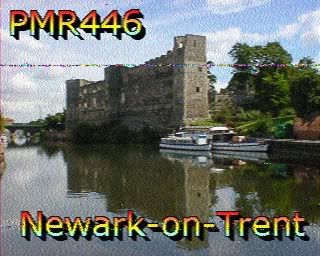
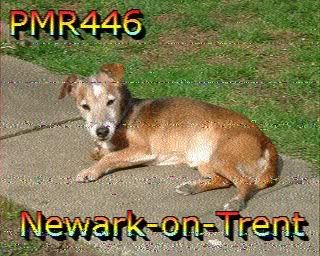
From these encouraging results definitely some more experiments to be done on this, and some tests further afield!
Being unlicensed the only legal equipment I can used is PMR446 these are low power (500mW) handheld transceivers with very limited range. I have several some older models kicking about from when I built a eQSO internet PMR446 gateway.
The SSTV image is transmitted by frequency modulation using a varying audio tone to indicate different brightnesses. The software I have been using to decode SSTV is MMSSTV by JE3HHT (Makoto Mori) It can also be used to transmit SSTV images by connecting the audio output of the PC to the transmitter audio in. It allows editing and customisation of the images and the encoding format to use.
Obviously I couldn't carry a PC around so instead I generated some images and recorded the generated sound to a WAV audio file and then used an old cheap MP3 player (which supported WAV files) connected to one of the Audiovox PMRS-838 handsets, configured to operate in VOX mode.

The plan was to drive around to a number of local high spots and with the transceiver on the dashboard of the card output a series of images and see if they could be received and decoded back at base! - Each image taking around 2 minutes to transmit.
The base receiver was my Alinco DJ-X3 connected to the loft based discone. I had to use the DJ-X3 because it supports to 6.25kHz narrow band channel step required by the PMR446 channel allocations.

Well the first set of results today have been pretty good, I went to three sites to transmit from and using the terrain profiler on HeyWhatsThat.com I could calculated any obstacles in the line of site..The base is on the left hand side, the transmission point on the right of the diagrams below.
Site 1, was 0.9 miles from home This site is just across on the other side of the Trent Valley with no significant buildings in the transmission path.

as you can see the five images all came across very well, just a slight sync error on one.





Site 2, was 1.2 miles from home and is one of the local high spots. Unfortunately there is a housing estate on the top of the hill. It is possible to go by foot on some footpaths to get into some fields with a clear vantage point across the town and down the Trent Valley towards Nottingham. However today these were from the car parked up near to the edge of the estate. I just sent two images - and they are a lot nosier.



Site 3, was 3.2 miles from home and is on a slight high spot across on the other side of the Trent Valley. I parked up in a layby and transmitted three images and really wasn't expecting much. So was very pleasantly surprised by the high quality of the received images, as you can see there isn't any geographical obstruction but there is a very big new power station at Staythorpe in the line of transmission which I expected to cause some issues. Some of the lines of noise on the images I suspect were caused when large lorries and vans were passing by on the road momentarily blocking the transmission path as it is quite a busy road.




From these encouraging results definitely some more experiments to be done on this, and some tests further afield!
Subscribe to:
Posts (Atom)
































